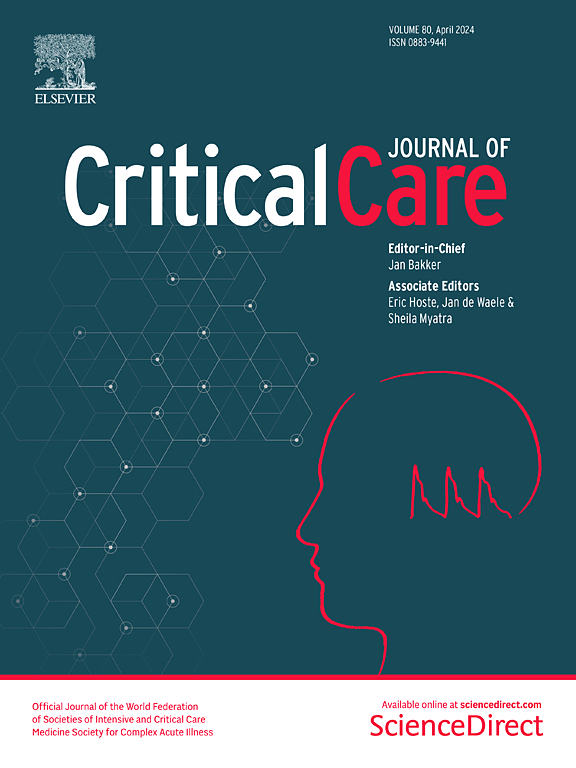ICU脓毒症相关急性肾损伤流行病学与当代共识定义
IF 8.8
1区 医学
Q1 CRITICAL CARE MEDICINE
引用次数: 0
摘要
脓毒症相关急性肾损伤(SA-AKI)的定义于2023年更新。本研究旨在用最新的共识定义描述SA-AKI的流行病学,并评估临床结果。该研究是在两个学术医疗中心进行的回顾性队列分析。纳入2010年至2022年间入住重症监护病房(ICU)的成年患者,并将其分类为SA-AKI、单纯脓毒症或单纯AKI。SA-AKI进一步根据发病时间(脓毒症诊断后早期< 2天vs脓毒症诊断后2 - 7天)和是否存在感染性休克进行分类。临床结果包括出院时的住院死亡率和主要肾脏不良事件(MAKE =死亡、肾脏替代治疗或肾功能较基线下降)。纳入187,888例成人ICU患者,近一半的脓毒症患者和约六分之一的ICU入院患者发现SA-AKI。1 / 4的SA-AKI患者在住院期间死亡,37.7%的患者在出院时至少发生一次MAKE。与脓毒症或单纯AKI相比,SA-AKI与更高的死亡率相关(调整后HR 1.59;95% CI 1.51-1.66)和更高的MAKE几率(调整OR 3.35;95% ci 3.19-3.51)。SA-AKI的早期临床表型是最常见的,从脓毒症开始,AKI的发生率每天都在下降。脓毒性休克的存在显著恶化了预后。应用更新的共识定义强调了SA-AKI在ICU的高患病率及其显著相关的发病率和死亡率。结果因临床表型而异,包括SA-AKI发病时间和休克的存在。本文章由计算机程序翻译,如有差异,请以英文原文为准。
Epidemiology of sepsis-associated acute kidney injury in the ICU with contemporary consensus definitions
The definition of sepsis-associated acute kidney injury (SA-AKI) was updated in 2023. This study aims to describe the epidemiology of SA-AKI using updated consensus definition and to evaluate clinical outcomes. The study was a retrospective cohort analysis conducted at two academic medical centers. Adult patients admitted to intensive care units (ICU) between 2010 and 2022 were included and categorized as SA-AKI, sepsis alone, or AKI alone. SA-AKI was further classified by time of onset (early < 2 days from sepsis diagnosis vs. late 2–7 days following sepsis diagnosis) and presence of septic shock. Clinical outcomes included hospital mortality and major adverse kidney events (MAKE = death, kidney replacement therapy, or reduced kidney function from baseline) at discharge. 187,888 adult ICU patients were included, and SA-AKI was found in nearly half of sepsis patients and about 1 in 6 ICU admissions. 1 in 4 patients with SA-AKI died during hospitalization and 37.7% experienced at least one MAKE by hospital discharge. Compared to sepsis or AKI alone, SA-AKI was associated with higher mortality (adjusted HR 1.59; 95% CI 1.51–1.66) and higher odds of MAKE (adjusted OR 3.35; 95% CI 3.19–3.51). The early clinical phenotype of SA-AKI was most common, with incident AKI decreasing daily from sepsis onset. The presence of septic shock significantly worsened outcomes. Applying updated consensus definitions highlights the high prevalence of SA-AKI in the ICU and its significant associated morbidity and mortality. Outcomes differ based on clinical phenotypes, including the timing of SA-AKI onset and the presence of shock.
求助全文
通过发布文献求助,成功后即可免费获取论文全文。
去求助
来源期刊

Critical Care
医学-危重病医学
CiteScore
20.60
自引率
3.30%
发文量
348
审稿时长
1.5 months
期刊介绍:
Critical Care is an esteemed international medical journal that undergoes a rigorous peer-review process to maintain its high quality standards. Its primary objective is to enhance the healthcare services offered to critically ill patients. To achieve this, the journal focuses on gathering, exchanging, disseminating, and endorsing evidence-based information that is highly relevant to intensivists. By doing so, Critical Care seeks to provide a thorough and inclusive examination of the intensive care field.
 求助内容:
求助内容: 应助结果提醒方式:
应助结果提醒方式:


